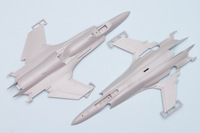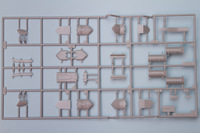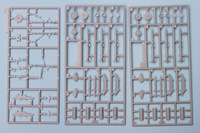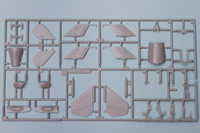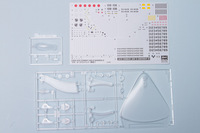
Hasegawa 1/72 Ace Combat ASF-X Shinden II
By Chris Banyai-Riepl
Overview
Ace Combat is a flight simulation game series put out by Namco Bandai currently with a dozen individual games. Originally designed for the Sony Playstation platform, there have been several releases for other platforms, including the Microsoft Xbox 360. The aircraft included in the games have generally been standard aircraft such as the F-22 or Su-27, but there have also been a few aircraft that were designed specifically for the game. The ASF-X Shinden II is such an aircraft, released as the first downloadable aircraft in the Ace Combat: Assault Horizon game. A multi-role aircraft, the ASF-X is a twin-engined highly maneuverable aircraft with plenty of firepower. With the second engine positioned forward in the fuselage for VTOL capability, the ASF-X is one of the best aircraft in the game.
The Kit
Typical of Hasegawa, this kit comes molded in their usual light gray plastic and features quite a bit of nice detail straight out of the box. You get a detailed interior, lots of external stores, optional positioning of tailplanes, and a choice of marking schemes. Surface detail is the expected recessed panel lines, and given the unique geometry of the plane, the kit includes a stand to show the plane in some of the more dramatic layouts. Construction, like any other aircraft kit, begins with the innards, and here you'll find some rather complex assemblies aimed at enhancing the detail of this model. The engine exhausts are made up from quite a few pieces, from the two piece inner trunk to the multi-piece vectored thrust nozzle. The complex arrangement of the jet exhausts of this plane will mean some odd challenges here.Luckily, the cockpit is much simpler, with a basic but nicely detailed four-piece seat that only needs seatbelts, an instrument panel and hood with a separate clear heads up display, and the main cockpit tub molded into the upper fuselage half. Should you wish to avoid the seatbelt issue, there is a pilot figure provided, with separate arms and head for adjustable positioning. A separate control stick rounds out the interior.
The main assembly is quite simple, as the fuselage/wings are combined in a split upper and lower assembly. Separate are the wing tips, canards, and rear vertical fins. These rear fins are designed to be positioned in multiple orientations, as are the wing tips. Between those two parts, there are a whole host of display options that can ensure your Shinden II has that unique look.For those who want to use the included stand, it is a simple matter to affix the closed wheel doors and move on to the next step. If you want to put this on landing gear, this is fairly straightforward, as both the nose gear and main gear legs are simple one-piece assemblies with separate wheels. Likewise, the canopy is simple and can be displayed open or closed, depending on which parts you choose.
With the basics done, the next step is the weaponry. This kit comes with a simple pair of options: air-to-air missiles or air-to-ground rocket pods. The missiles are AIM-120 AMRAAMS, while the rocket pods are just your generic 20-round FFAR pods. There are six wing-mounted pylons, each holding a single weapon. Looking at this I have to wonder, why bother with all this stealthy curves and shapes to the aircraft when you're just going to plop six giant radar reflectors under the wings. For markings, there are two choices provided in the kit, both Japanese. The first is the standard air superiority scheme consisting of two shades o gray, similar to what is currently worn on their F-15 Eagles. Markings are simple, consisting of hinomarus on the fuselage and wing, with serial numbers and squadron emblem on the tail and a separate nose number. The second option is the maritime scheme, consisting of blue upper surfaces and gray lower surfaces. Again, serial numbers and unit insignia are on the tail, and an individual aircraft number is on the nose. The decals also include a fair amount of stenciling, and all are well printed and should present no challenges in application.Conclusion
This is an interesting release for Hasegawa, as it is a subject that does not exist in real life, but it is definitely unique shape and opens up some fun potential for alternative markings. My thanks to Hasegawa USA for the review sample.

